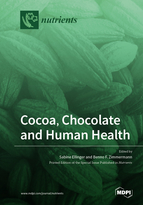Cocoa, Chocolate and Human Health
A special issue of Nutrients (ISSN 2072-6643).
Deadline for manuscript submissions: closed (15 March 2019) | Viewed by 96611
Special Issue Editors
Interests: antioxidants; dietary interventions and wound healing; cocoa; flavanol; prevention and cardiometabolic effects
Special Issues, Collections and Topics in MDPI journals
Interests: HPLC; UHPLC; polyphenols; flavonoids; food analysis; metabolites; bioavailability; green tea; cocoa
Special Issues, Collections and Topics in MDPI journals
Special Issue Information
Dear Colleagues,
The health-promoting effects of cocoa have attracted a great deal of attention from researchers, and also from health-conscious consumers, and manufacturers of cocoa. Thus, flavanol-rich cocoa products, obtained from gentle cocoa processing, are commercially available.
This Special Issue of Nutrients encourages the submission of original research or reviews of scientific literature, revealing the remaining secrets behind cocoa: What are the candidate compounds in cocoa and cocoa-rich products for beneficial effects in humans beyond flavanols? How are these compounds affected by cocoa processing? What is known about their bioavailability and their metabolic fate? Is there evidence on health-promoting effects of cocoa, based on randomized controlled studies? Does the consumption of special cocoa products in usual amounts and cocoa-based functional food really provide health-related benefits? Do we have to consider adverse effects of cocoa components, especially in enriched products?
Prof. Dr. Sabine Ellinger
Dr. Benno F. Zimmermann
Guest Editors
Manuscript Submission Information
Manuscripts should be submitted online at www.mdpi.com by registering and logging in to this website. Once you are registered, click here to go to the submission form. Manuscripts can be submitted until the deadline. All submissions that pass pre-check are peer-reviewed. Accepted papers will be published continuously in the journal (as soon as accepted) and will be listed together on the special issue website. Research articles, review articles as well as short communications are invited. For planned papers, a title and short abstract (about 100 words) can be sent to the Editorial Office for announcement on this website.
Submitted manuscripts should not have been published previously, nor be under consideration for publication elsewhere (except conference proceedings papers). All manuscripts are thoroughly refereed through a single-blind peer-review process. A guide for authors and other relevant information for submission of manuscripts is available on the Instructions for Authors page. Nutrients is an international peer-reviewed open access semimonthly journal published by MDPI.
Please visit the Instructions for Authors page before submitting a manuscript. The Article Processing Charge (APC) for publication in this open access journal is 2900 CHF (Swiss Francs). Submitted papers should be well formatted and use good English. Authors may use MDPI's English editing service prior to publication or during author revisions.
Keywords
- cocoa
- chocolate
- cocoa composition and processing
- randomized controlled trials
- flavanols
- further cocoa ingredients with health-promoting properties
- functional food








